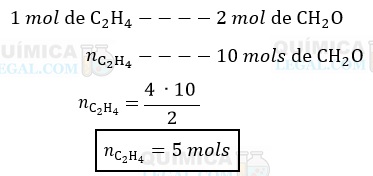Na poluição atmosférica, um dos principais irritantes…
(PUC-RJ 2001) Na poluição atmosférica, um dos principais irritantes para os olhos é o formaldeído, CH2O, o qual é formado pela reação do ozônio com o etileno:
O3(g) + C2H4(g) → 2 CH2O(g) + O(g)
Num ambiente com excesso de O3(g), quantos mols de etileno são necessários para formar 10 mols de formaldeído?
a) 10 mols
b) 5 mols
c) 3 mols
d) 2 mols
e) 1 mol
Utilize a tabela periódica para calcular as massas molares quando necessário.
Resolução
De acordo com a equação química, já balanceada, a reação de 1 mol de etileno produz 2 mols de formaldeído. Assim, a quantidade de matéria de etileno necessária para produzir 10 mols de formaldeído, é dada por:

Gabarito: LETRA B
Confira mais EXERCÍCIOS RESOLVIDOS sobre ESTEQUIOMETRIA.
Tá afim de ver mais RESOLUÇÕES COMENTADAS da PUC?



